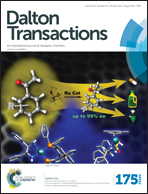Coordination polymers of Fe(iii) and Al(iii) ions with TCA ligand: distinctive fluorescence, CO2 uptake, redox-activity and oxygen evolution reaction†
Abstract
Fe and Al belong to different groups in the periodic table, one from the p-block and the other from the d-block. In spite of their different groups, they have the similarity of exhibiting a stable 3+ oxidation state. Here we have prepared Fe(III) and Al(III) based coordination polymers in the form of metal–organic gels with the 4,4′,4′′-tricarboxyltriphenylamine (TCA) ligand, namely Fe–TCA and Al–TCA, and evaluated some important physicochemical properties. Specifically, the electrical conductivity, redox-activity, porosity, and electrocatalytic activity (oxygen evolution reaction) of the Fe–TCA system were noted to be remarkably higher than those of the Al–TCA system. As for the photophysical properties, almost complete quenching of the fluorescence originating from TCA was observed in case of the Fe–TCA system, whereas for the Al–TCA system a significant retention of fluorescence with red-shifted emission was observed. Quantum mechanical calculations based on density functional theory (DFT) were performed to unravel the origin of such discriminative behaviour of these coordination polymer systems.


 Please wait while we load your content...
Please wait while we load your content...